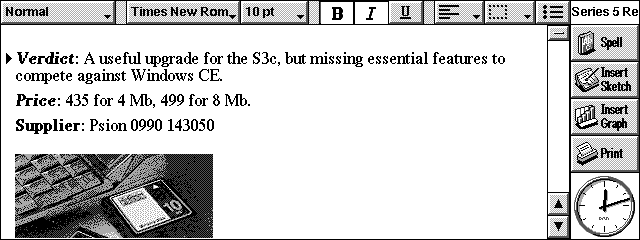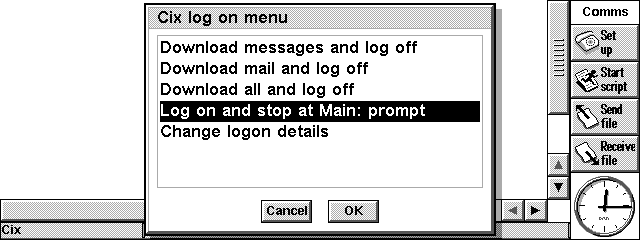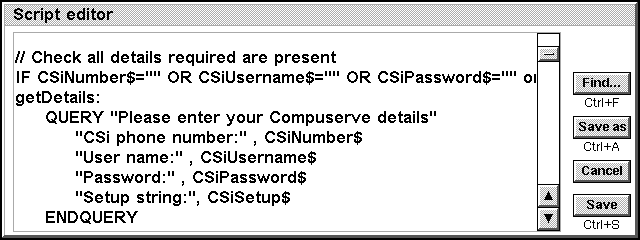
Psion Series 5 redux
Since taking a first look at the new Psion Series 5 last month, I have using it constantly. Looking at a list of capabilities, or even comparing the Series 5 directly, feature for feature, against a Series 3c, is a starting point for making a serious evaluation of the new machine; but it isn't enough to grasp the subtle way in which very small changes in specification will influence the way you will use it.
The hardware is, without a doubt, much sturdier and better designed than any of the current crop of Windows CE machines, with whom it shares an almost identical specification. The way the case opens and shuts, all the connector covers operate, and the way that the case can be left to sit stably on a desk without rocking backwards and forwards gives you that Rolls Royce feeling. The hardware design looks almost unfinished without a Design Centre award stuck underneath the keyboard, next to the FCC logo (and where there really should be a CE logo showing).
The minutiae of the design go together to give this impression; but the keyboard really is too good to be lumped in with all the rest of the details. It is a real touch typists keyboard, just at the lower size limit of acceptability, beating the (larger) Libretto keyboard easily, and far ahead of any other PDA keyboard. My lasting memory of the Series 5 from the last month was attending a meeting where all the people were sitting typing away at Apple PowerBooks, apart from myself with the Series 5. The size comparison in itself was amusing, but I could do equally easily everything that they wanted from their laptops; with the one exception that as I left the meeting, I couldn't plug in to their corporate network and fire off the half a dozen emails that I had written during its course.
In the past few weeks I have been talking with Series 3 owners to see how they react to the new machine. There are some important new features in the Series 5 that were never present in the Series 3: a proper graphical user interface, object linking, better WYSIWYG presentation, and the resources of a proper 32 bit operating system that remove some of the memory constraints of old Series 3 applications. But there are equally many relatively small features lost. I can't presume to think why Psion would have done this, but the impression is of a machine that was hurried out of the door before the software was completed.
Text effects and Object links in Word

In Word, there is no longer a capability to export to rtf on the Series 5 itself. You have many more conversions available than before through PsiWin; but to use PsiWin you have to have a desktop PC with Windows 95 or NT with you. If you prefer not to carry an extra full size system in your baggage, or are one of the many who use an older Microsoft operating system, no Microsoft operating system, or even no desktop machine at all, this could be a problem. There is also no longer a separate Jotter application, or an outline mode for viewing documents.
Sheet can't sort ranges, and also can't print a range. You only have to option to print an entire document, although you can set page breaks where you like and choose to print only selected pages. It is also not possible to define a function in OPL, Psion's programming language (you could do this in the Calc application on the Series 3, but not on the Series 5 at all).
Agenda is missing the Month view, but otherwise is very close to the Series 3. You can now have appointments that span midnight, and can use images inside the records to make your actions much clearer on the screen, for example. It also synchronises very well with PC based agendas like Schedule+. Support for MS Outlook is absent, but Psion say that they are considering it.
PsiWin 2.0 is a big improvement over PsiWin 1. You can still use the older packages to backup and exchange files with a Series 5, and a Series 3 machine will work with PsiWin 2.0, but you need both PsiWin 2.0 and a Series 5 to synchronise Agendas. The really big problem, and there are a couple of small ones as well, is that there is no way to synchronise Contacts from a PC with the Data application. As far as I am concerned, for potential corporate users this is a show stopper (and there are a couple more). I tried exporting my Schedule+ Contacts database to CSV (comma separated values) format, but when I did PsiWin refused to import it. It seems that any blank fields will cause a file to be rejected, and there will be many of those in a Contacts database. I was eventually able to get most of my contacts over to the Series 5, but by moving the CSV file onto the Series 5 without conversion, and then loading it in as text directly into Data. This worked.
PsiWin doesn't have any converters for sound or image files. Psion supply a command line converter on the PsiWin CD, but this is much harder than using a built in filter.
When you first install PsiWin, it scans all of your serial ports and infrared port to locate an attached Psion. However, any other devices you may have attached will be probed as well, and this can cause problems, particularly with modems. So if you already have a modem attached to your system, and are experiencing problems after installing PsiWin, that is the cause. Once you set the specific port you are using in Preferences, that problem goes away. I was also unable to establish communications through an infrared (IrDA) port. Windows 95 would recognise the name of my Series 5, but neither the Psion or PsiWin would connect across it. Several other users have also reported this.
Another minor quirk is that the Task Bar Psion program will report a heart beat of a connected Psion, but you still have to explicitly issue a connect command in PsiWin before the connection will show up in Windows Explorer.
Psion have dropped support for their old SSD memory cards that worked with the Series 3. Instead, a single slot of Compact Flash cards is included. This is a missing feature that I welcome. SSD was a good format given the time of its design, but the world has moved on a long way since then. Compact Flash is amazingly small, and remarkably cheap. You can buy 4, 8, 10 and 15 Mb Compact Flash cards that are supplied to work with digital cameras from some computer shops, and some camera shops. I found an 8 Mb SanDisk card in Jessops in New Oxford Street for about 150 pounds, which is pretty reasonable for a new technology. This comes with an slip on adaptor for using the card in PCMCIA slots. The card worked immediately in the Series 5, and with the adaptor worked in a Windows 95 laptop and a Windows CE system (a Casio Cassiopeia), and it could see the Psion file system and move files around. Unfortunately, it isn't possible to use the converters in PsiWin if you use this technique.
Moving image files from a Series 5

One minor pleasure of using a Psion Series 3 that I remember from several years ago was the Comms application. With the right combination of cables and adaptors, it could plug into the serial port of a router, a Unix machine, or any of a number of minis and mainframes, and pretend to be a terminal. Having a competent terminal substitute in my pocket improved my quality of life dramatically when I was working as a contract systems administrator at a large Unix customer. Prior to my Series 3, we had a big trolley with an equally big Compaq luggable on it. Pushing it around to whichever machine we had to reconfigure, across a floor strewn with fibre optic cables over which we had to lift the trolley, was back breaking. The Series 3 (and don't forget the bundle of cables) banished all of that. The Comms application also had a very powerful scripting language, and that has been carried forward to the Series 5, which can now show a full 80 by 25 terminal display all at the same time.
Comms comes with a sample script to connect to CIX, the UK based bulletin board and ISP. This script has two minor problems with it. The first is that there is a spelling mistake in one of the messages it can produce when finding an error; the other is that it uses some modem setup strings that will produce an error and abort the script on most modems. My solution to this is to add the setup string information to the set up details which are read from a file into the script every time it runs, which is very easy to do.
the CIX Comms script

Another couple of small problems have arisen because of the change to a consistent graphical user interface, and because the application wasn't redesigned to take this into account. To edit a script, you have to open that script within a sort of text window, that doesn't have a menu bar, but instead gives just a couple of buttons down the right hand side of the text window to save, etc. This seems to be the way that the object linking system has been designed to work, as a couple of other applications do a similar thing. The problem is that you don't have access to the many menu bar functions available in Word. Some of the control key combinations still work, but not being able to reach the functions from the menu bars, including the screen printed menus down the left had edge of the display, is not an acceptable compromise.
Editing a Comms script

The key combination short cuts for menu functions have been changed from the old Psion key combinations to be Control key combinations, presumably to be consistent with the Windows user interface. I'm of the opinion that if something hurts, you should stop doing it, and this is a good example. What this seemingly innocuous change means is that you can no longer type, for example, Control C in the Comms application to abort a connection. I couldn't find a solution in the Comms manual (which is on the PsiWin CD ROM in Adobe Acrobat format - which can't be read on a Series 5), although I am told it is there. I could find how to insert control characters into a script in the manual, though. The answer is that you need to press the function key as well as the control key and the key of your choice.
The other problem with Comms is another example of functions that were present in the Series 3 that are missing from the Series 5. It includes Xmodem and Ymodem file transfer protocols, but not Zmodem. This isn't in itself a big problem, except that I couldn't upload files with Ymodem to CIX, and Xmodem gets file sizes wrong. The good news is that, despite uploading and downloading a Data file using Xmodem, the Series 5 could still use it.
I like having serial line terminal emulation available, both for direct connections and communicating via a modem. I would be much happier if I could use a PCMCIA modem, and a hip flask PCMCIA adaptor is due for release from Psion which should support modems. In the future I expect that a lot of the requirement for this will shift over to telnet based applications and scripting, using PPP over modems and with Ethernet PCMCIA cards, but we don't have the facilities available yet from Psion to do this.
Reports from the first units of the Series 5 to go on sale have indicated a few problems with quality control, many of those the areas that would be expected. It isn't possible to say if more problems are being reported than would be usual; I don't think that there are. If you are buying a Series 5, open the box first and test it out. If you don't like it, you can ask the shop to open another one for you. Look out for dead or damaged screens, noisy or sticky hinges: these are typical problems that any machine might exhibit. Also watch for sticky keys on the keyboard; they should loosen with use, so I don't think this would be a big problem.
I said earlier that small, subtle changes to a system can have a major impact on the way that it is perceived, and we have plenty of examples of those changes. Taken together, they force a lot of dependence on functionality in an attached desktop PC running Windows 95 or NT, to the extent that some important functions can't be managed without a desktop PC. The Series 3 was a determinedly stand alone system, with functionality so great that many people chose to use it instead of a PC. Many other Series 3 users prefer to organise their life around their Series 3, and view a desktop system as a very much subsidiary adjunct to their PDA. The changes in specification have shot this world view to pieces, and some existing Psion customers are upset about it.
Psion clearly want to view the Series 5 without regard to their existing user base, rather like a naive new MBA graduate conducting a marketing exercise. They are looking to compare it with Windows CE: the hardware is without question better, and the software is better where it matches. But CE is pitched at corporate customers who are fascinated and bemused by Microsoft, and for those customers email and synchronisation of contacts databases is essential. The signs are there in the missing functionality that Psion have rushed the software for a launch to be compared against CE; but Microsoft are gearing up for the launch of CE 2.0 later this year. If Psion are being compared now against CE and failing badly, corporate buyers will forever condemn them to be passed over when CE 2.0 is launched, even if the facilities available at that time in the Series 5 will make it look sick in comparison.
The danger is that, being basically better than Windows CE, but missing essential features, buyers will look instead to compare the Series 5 against 3com's PalmPilot on its own grounds. As a pocket agenda with PC synchronisation, the PalmPilot is half the size and half the price of the Psion, with better synchronisation. On those grounds, the PalmPilot wins.
The Series 5 really is a powerful pocket computer, in a way that no other PDA, even the Newton, is. It must have full synchronisation capabilities, but it should be able to function fully as a stand alone computer. I'd expect to see a full set of file transfer protocols (Xmodem, Zmodem, ftp) and basic file formats supported, without requiring the use of a desktop machine with PsiWin. Preferably supporting ascii, csv (and/or tab delimited, which I believe is a lot better), rtf, Lotus WK1 or DIF or SYLK, and gif and jpg as standard graphics formats.
Words and design by:
Paul Lynch
Last updated: July 30, 1997